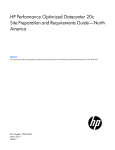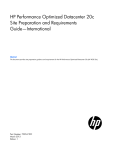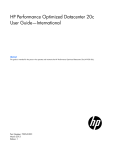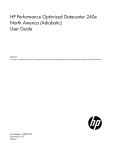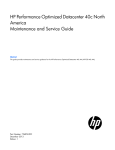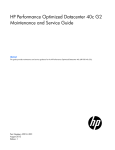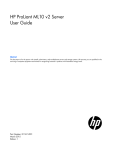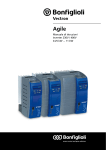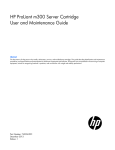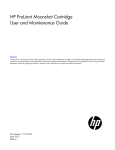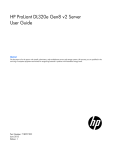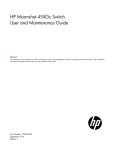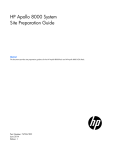Download HP 240a Getting Started Guide
Transcript
HP Performance Optimized Datacenter 240e
North America (Adiabatic)
Site Preparation and Requirements Guide
Abstract
This guide is intended for the person who operates and maintains the HP Performance Optimized Datacenter 240e NA (HP POD 240e NA).
Part Number: 748898-001
November 2013
Edition: 1
© Copyright 2013 Hewlett-Packard Development Company, L.P.
The information contained herein is subject to change without notice. The only warranties for HP products and services are set forth in the express
warranty statements accompanying such products and services. Nothing herein should be construed as constituting an additional warranty. HP shall
not be liable for technical or editorial errors or omissions contained herein.
Contents
Overview ..................................................................................................................................... 5
About this document .................................................................................................................................. 5
Safety and NEC compliance ....................................................................................................................... 5
Site assessment ......................................................................................................................................... 6
Site preparation ........................................................................................................................................ 6
Site safety and security .............................................................................................................................. 6
Fire detection ............................................................................................................................................ 6
Capacities ................................................................................................................................................ 6
Site requirements .......................................................................................................................... 7
Site pad ................................................................................................................................................... 7
Weight requirements ................................................................................................................................. 7
Dimensions and required clearances ............................................................................................................ 7
Future expansions ............................................................................................................................ 9
Racks ....................................................................................................................................................... 9
Cold aisle clearance ................................................................................................................................ 10
Grounding requirements ........................................................................................................................... 10
Utilities ................................................................................................................................................... 12
System utilities ............................................................................................................................... 12
Power .......................................................................................................................................... 13
Supported facility connections ...................................................................................................... 16
Environmental control system .................................................................................................................... 16
Connections to central facility infrastructure ................................................................................................ 16
Connection portals ........................................................................................................................ 16
Demarcation box ........................................................................................................................... 18
Fire box ....................................................................................................................................... 18
Access control......................................................................................................................................... 19
Fire, safety, and access notifications .......................................................................................................... 19
Environmental considerations ....................................................................................................... 21
Environmental risks .................................................................................................................................. 21
Cold weather .......................................................................................................................................... 21
Areas prone to lightning or power surges ................................................................................................... 21
Seismic activity ....................................................................................................................................... 21
Site plan requirements and actions ............................................................................................... 22
Completing a site assessment .................................................................................................................... 22
HP Site Preparation Drawing Package ....................................................................................................... 22
Zoning and permit requirements ................................................................................................................ 22
Project coordination................................................................................................................................. 22
Site planning .......................................................................................................................................... 23
Installation .................................................................................................................................... 23
Appendix A: HP site assessment ................................................................................................... 25
HP POD 240e NA site assessment checklist ................................................................................................ 25
Appendix B: Preparing for delivery ............................................................................................... 28
Pre-delivery tasks ..................................................................................................................................... 28
Contents
3
Installation prerequisites ................................................................................................................. 28
HP POD 240e NA site readiness checklist .................................................................................................. 28
Contacting HP ............................................................................................................................ 31
Before you contact HP.............................................................................................................................. 31
HP contact information ................................................................................................................... 31
Regulatory compliance notices ..................................................................................................... 32
HP POD 240e NA regulatory compliance .................................................................................................. 32
Safety and NEC compliance ........................................................................................................... 32
Safety and regulatory compliance ............................................................................................................. 33
Turkey RoHS material content declaration ................................................................................................... 33
Ukraine RoHS material content declaration ................................................................................................. 33
Warranty information .............................................................................................................................. 33
Glossary .................................................................................................................................... 34
Documentation feedback ............................................................................................................. 37
Index ......................................................................................................................................... 38
Contents
4
Overview
About this document
This document outlines the site preparation requirements for an HP Performance Optimized Datacenter 240e
NA. You must provide a qualified architectural or consulting engineering team to generate site-specific
documents for each HP POD 240e NA installation, including final site drawings. Your site installation design
must comply with all local and national regulations, ordinances, codes, and the specifications listed in this
document.
Safety and NEC compliance
The HP POD 240e NA is Listed to UL 69050 Part 1 and Part 22 as an Information Technology Product and
Classified in accordance with the National Electric Code NFPA 70.
The HP POD 240e NA is not habitable or suitable for human occupancy. The HP POD 240e NA is Listed as
a Product that provides Service Access Areas for periodic maintenance and service. Access to these areas
must be controlled and available for use only by owner-authorized and qualified personnel who are trained
in the maintenance and service of the HP POD 240e NA components. For more information, see "HP POD
240e NA regulatory compliance (on page 32)."
IMPORTANT: Before installing the HP POD 240e NA, consult your local AHJ for applicable
regulations and to review site-specific location guidelines. If needed, obtain any necessary
permits.
Additional considerations for safety and NEC compliance are as follows:
•
The HP POD 240e NA is Listed as an Information Technology Equipment Product to UL 60950.
•
The HP POD 240e NA is evaluated as a "non-inhabitable product" that provides "service access" areas
for customer-authorized, qualified, and trained service personnel.
•
The electrical connections of the HP POD 240e NA are evaluated as feeder connections for connection
to an existing facility. The electrical connections are not suitable as "service entrance" for connection to
the utility.
•
The HP POD 240e NA is designed for stationary installation outdoors in a Pollution Degree 3
environment, in restricted access locations, and with field wiring terminals provided for permanent
supply connections.
•
The HP POD 240e NA meets the ratings in the following table.
Feature
Specification
Category
Rated Overvoltage Category III
Protection
Surge protection device
Class
Class1
Ambient temperature
2°C to 54°C (35.6°F to 129.2°F)
Relative humidity
0% to 100% humidity
Enclosure
NEMA 3R
Overview 5
•
As part of the overall certification, relevant sections of the International Building Code have been
applied as part of the design and evaluation. The current design supports wind loads up to 90 mph.
Site assessment
HP requires a detailed site assessment before planning and preparing your site location for the HP POD
240e NA. Consult with HP to schedule a site assessment.
Site preparation
Site preparation must be complete before the delivery of the POD for a timely installation and commissioning.
The site must meet all pad and power requirements.
Site safety and security
Your site must have its own standard safety and security requirements. HP Program Managers will work with
you to verify adherence to the appropriate precautions. HP is not responsible for determining or enforcing
safety or security requirements. You must conduct all health and safety evaluations of the HP POD 240e NA.
HP is available to help you be sure that you have successfully conducted these evaluations.
Fire detection
The fire detection system is supplied as a component of the HP POD 240e NA, and is Manufacturer Designed
specifically for this HP product, in compliance with national standards.
HP does not certify that the fire detection system that is installed in the HP POD 240e NA meets all local and
jurisdictional requirements. The customer is responsible for the following actions:
•
Verifying that the POD fire detection system meets local codes, including specific local requirements for
initial and periodic inspections
•
Arranging for and receiving all required local permits, including initial commissioning as well as
standard and repair maintenance
•
General maintenance of the fire detection system must be completed by an authorized technician
For more information, see the HP Performance Optimized Datacenter 240e NA Maintenance and
Service guide.
Any additional local requirements are not covered as part of the installation and deployment services of the
fire detection system, unless specifically included in an executed SOW.
Capacities
Each HP POD 240e NA is unique and the specific power and cooling capacities will vary for each POD that
uses Adiabatic cooling. For specific capacity information, see your HP Performance Optimized Datacenter
240e NA Customized Supplement.
Overview 6
Site requirements
Site pad
The structural design of the HP POD 240e NA site pad must be based on the specific weight load of the
complete POD solution with IT installed, as well as any additional equipment. During design calculations, HP
recommends that you provide structural support at the identified load pad locations of the HP POD 240e NA
to be sure that the POD remains level.
When preparing the site pad, be sure to adhere to the following requirements:
•
POD load pads are in the proper location.
•
Upon installation, the POD structure must be leveled to ≤ 0.5º, which can be checked atthat time with
a surveyor’s transit.
•
Shimming is allowed at the load pads only. Place shims in increments across the load pads to be sure
of a sufficient load transfer.
IMPORTANT: The HP POD 240e NA is designed for ground level installation. If you install the HP
POD 240e NA on an elevated surface, verify that the minimum height requirements for circuit
breaker actuators are considered per national, regional, local regulations, and electrical codes.
The area in front of the outside panels must include a work platform.
Weight requirements
IMPORTANT: The provided weights are estimates of the minimum and maximum weights. The
total weight of the HP POD 240e NA is based on the IT equipment and optional components that
are purchased and installed on the POD and might vary.
The HP POD 240e NA must be installed on a surface that is capable of supporting the following weights:
•
HP POD 240e NA with 12 AHUs—approximately 66,859 kg (147,400 lb)
•
HP POD 240e NA with 12 AHUs and IT equipment installed—maximum 138,309 kg (304,920 lb)
Dimensions and required clearances
The selected site for the HP POD 240e NA must be large enough to install, service, maintain, and potentially
upgrade the unit and the payload.
The following two examples show site clearance considerations:
•
If the HP POD 240e NA is to be installed in a warehouse, be sure that the warehouse doors are large
enough to accommodate each section of the HP POD 240e NA.
•
If the HP POD 240e NA is to be installed outdoors, be sure that adequate clearance exists for all
buildings, utility lines, or other site structures such as gates and headers.
Site requirements
7
Every site must have sufficient clearance for assembly, maintenance, and service, including such handling
devices as a forklift, scissor lift, boom lift, or crane. Be sure to provide adequate space around the HP POD
240e NA for airflow and cooling purposes.
IMPORTANT: Shaded areas indicate required clearances.
Top view clearances shown
End view clearances shown
Site requirements
8
Side view clearances shown
End view clearances shown
For additional dimensions, see the HP Site Preparation Drawing Package (on page 22).
Future expansions
When selecting a site location, consider future space and accessibility requirements. Adequate space
around the HP POD 240e NA is necessary for airflow and cooling purposes. Keep the specified areas clear.
For specific space requirements, see the HP POD 240e NA dimensions and required clearances.
Racks
The standard HP installed rack is a 50U rack. The HP POD 240e NA has 22 IT racks per IT section, for a total
of 44 IT racks.
During maintenance, if you remove filler panels for maintenance purposes, you must replace them. Cold-aisle
to hot-aisle separation must be maintained.
Site requirements
9
CAUTION: If any racks contain empty RU space, use the HP POD 240e NA filler panels to
maintain the efficiency of the HP POD 240e NA thermal system. Filler panels are available from
HP in 10-pack quantities (part number AQ682A) and 100-pack quantities (part number
AS993A).
For more information about racks and network cabling, see the HP Performance Optimized Datacenter
Networking Guide.
Cold aisle clearance
The maximum protrusion of any installed IT component directly impacts the available cold aisle clearance for
removal and replacement of other IT components. Maximum component depth must follow the clear aisle
distance calculations. The following figure shows how to calculate this distance.
The maximum rack face-to-cold aisle wall distance is 39.5 inches. In the figure, X represents any protrusion
into the cold aisle starting from the rack face of the installed IT component (for example, the bezel). Y
represents cold aisle clearance. The cold aisle clearance dictates the maximum depth (D) of any installed IT
component. To find the maximum cold aisle clearance, calculate 100.33 cm (39.5 in) - X = Y.
IMPORTANT: As the value for X increases, the value for Y decreases, which also decreases the
maximum depth allowed for an installed component.
Grounding requirements
The HP POD 240e NA structure and internal components are all bonded together. A common grounding
electrode conductor connection point is provided on the utility end of the IT sections.
WARNING: To avoid the risk of personal injury or electric shock, the HP POD 240e NA must be
properly grounded (earthed) in accordance with national, regional, and local regulations.
CAUTION: Remove paint from all grounding surfaces. Failure to do so results in an ineffective
ground.
Site requirements
10
The following is a list of component requirements for grounding and bonding:
•
Grounding of the HP POD 240e NA must comply with the requirements of Article 250 of the NEC,
NFPA 70-2011 (NA/JPN), and with local and regional regulations (IEC for EMEA and AP).
•
Bonding of the piping systems and any exposed structural steel, installed to support the HP POD 240e
NA, must be in accordance with NEC (NA) and with local and regional regulations (IEC for EMEA and
APJ).
Grounding feature
Specification
Grounding electrode
conductor pad
•
•
The grounding electrode conductor connection bus pad is located on the outside of
the HP POD 240e NA on the cold aisle adjacent to the power cabinet.
The grounding pad must be connected to the grounding electrode system or
building steel in accordance with Article 250 of the NEC or equivalent regional
regulations.
Grounding lugs
•
•
Ground rod system or
ground well
You must provide an effective grounding system with a ground rod or a ground well.
Grounding lugs cannot be attached to any painted surface.
Grounding lugs must be compression-type 2-hole lugs and UL listed specifically for
grounding.
IMPORTANT: Before installing the HP POD 240e NA, consult your local AHJ for applicable
regulations and to review site-specific location guidelines. If needed, obtain any necessary
permits.
The grounding electrode conductor connections are located on IT sections A and B of the HP POD 240e NA.
The following figure shows the location for both of the IT sections.
Side view shown
Site requirements
11
Utilities
Consider the proximity to required utilities, such as power, water, and network connections. While the
required utilities can be brought to nearly any selected site, there is the potential for increased costs and
decreased efficiency when the HP POD 240e NA is located farther from the utility sources.
For utility clearance information, see "Dimensions and required clearances (on page 7)."
System utilities
The site location must accommodate the following utilities:
•
Water supply (on page 12)
•
Drain locations (on page 13)
•
Power (on page 13)
Water supply
An external source of water must be provided for saturating the evaporative media. When the HP POD 240e
NA begins operation, the supplied water is used in conjunction with the evaporative media to provide the
specified cooling.
The supply water must meet the following requirements.
Requirement
Specification
Pressure
20-70 psi (138-483 kPa)
Temperature
Between 1 °C and 30 °C
Instant flow-rate
No lower than the rated flow of the
fill solenoid valve (1.5 gpm
maximum flow per Adiabatic unit,
maximum instantaneous).
Connection
¾”
Hardness
No greater than 40°fH (equal to
400 ppm of CaCO3)
Conductivity
100 to 1250 μS/cm
Organic compounds
None
Type of water
Demineralized is preferred.
Drinking potable water is
acceptable and most likely.
IMPORTANT: To connect the cooling system, a 0.0127 meter (½ inch) OD copper adapter is
needed for water piping.
IMPORTANT: If your water is out of range of these requirements, consult a water quality expert.
In addition to the previous requirements, follow these guidelines:
•
Do not treat the water with softeners. Softeners might produce foam, which affects the operation of the
unit.
Site requirements
12
•
Do not use well water, industrial water, water from cooling circuits, or water contaminated by any
chemicals or bacteria.
•
Do not add disinfectants or anticorrosive compounds to the water, which are potential irritants.
•
HP highly recommends installing a filter to be sure that water is free of particles.
Drain locations
The following figure shows the drain locations on the HP POD 240e NA.
Side view shown
Callout
Component
Description
1
Adiabatic media
drain
Rain water drain
Removes excess water from the
2
adiabatic media drip tray
Removes rain water from the HP POD 2
240e NA
2
Quantity per
side
Total quantity
per HP POD
240e NA
4
4
IMPORTANT: Consult with your AHJ to determine the appropriate drainage system routing.
Power
Site requirements
13
IMPORTANT: To provide power to the HP POD 240e NA, external transformers and
switchboards might be required. This equipment must be designed and installed to adhere with
local, state, and national codes, and installed by contractors with licensing required by the local
jurisdiction; city, township, and state.
For all site preparation drawings, see the HP Site Preparation Drawing Package (on page 22).
Site electrical system
To be sure that there is a complete and safe integration of the HP POD solution within your facility, HP
requires that you complete the following actions for the installed electrical system before the installation of the
HP POD solution:
•
Short circuit analysis
•
Arc flash study
•
Circuit breaker coordination study
These actions must be performed for all associated parts of the electrical power train. The majority of the
details and factors required to complete these studies are associated with the existing installed facility
infrastructure.
CAUTION: Failure to complete these studies can cause serious issues with the electrical
integration of the POD into your electrical system.
Electrical power system configuration
A preliminary meeting with the HP POD Electrical Engineering team is necessary to discuss your decision
concerning capacity limitations and the impacts of this decision on the electrical design.
When determining the final location of the power connections, consider the following:
•
Distance between the facility utilities and the location of the HP POD 240e NA
•
Distance between possible UPS or generator locations and the HP POD 240e NA
•
Requirements for routing electrical feeders (underground or overhead)
The facility power connection must be installed in compliance with local electrical codes and regulations. The
HP reference electrical installation design is based on a maximum distance of 15.2 m (50 ft) or a line of sight
between the disconnect and the HP POD 240e NA. You are required to discuss your decision concerning
capacity limitations, and the impacts of this decision, on the electrical design with the POD Electrical
Engineering Team.
A 1N electrical configuration can be achieved by providing all of the required electrical feeders from a
common power source, common switchboards, and transformers.
A 2N electrical configuration can be achieved by feeding parallel power paths from independent power
sources, switchboards, and transformers.
IMPORTANT: All 3-phase wye feeders for the HP POD 240e NA require that the neutrals and the
equipment grounding conductors remain isolated. Bonding of the two conductors is allowed at
the power source only.
Site requirements
14
Transformers and switchboards
The input power for the Critical IT Loads requires a source of 380-415V, 3phase wye power. If it does not
already exist at the source, you might have to obtain custom transformers to derive this power. In addition to
the overall loading and KVA size, you must consider the Harmonic Content of the installation when
specifying the K-Factor of the transformers. Alternatively, you can use Harmonic Mitigating Transformers to
passively cancel the harmonics generated by the IT equipment.
HP offers several power solutions that include automatic transfer switching, UPS backup, transformers and
output distribution switchboards to supply your power needs.
On-site connections might include:
•
Main facility power to the primary side of the transformer
•
Transformer to the switchboard
•
Switchboard assembly to the HP POD 240e NA
For connection information, see the HP Site Preparation Drawing Package (on page 22).
Site requirements
15
Supported facility connections
Environmental control system
The ECS developed for the HP EcoPOD is a stand-alone control system that requires no external connections
with an external site system, BMS, public or private Internet sites, cloud, or wireless system to properly control
the POD operation.
The ECS includes Modbus TCP/IP connections through which a variety of data can be retrieved. These
capabilities enable you to connect, at your expense, with the stand-alone ECS system to monitor the
operating parameters of the POD. It is your responsibility (or your representative's or agent's responsibility)
to integrate this communication capability into any existing BMS or monitoring system.
CAUTION: To be sure that alarm conditions can be identified and resolved, HP recommends that
you remotely monitor all alarm conditions. Failure to monitor the alarm conditions can cause
delays in appropriate action during an alarm condition.
Connections to central facility infrastructure
The HP POD 240e NA is designed to function as a standalone unit and provides various connection points
to your facility. It is your responsibility to facilitate these connections. HP can make these connections when
specifically contracted to deliver these services and a SOW has been drafted, reviewed, and signed for
delivery services. Available POD connections include the following:
•
•
•
•
HP POD 240e NA Environmental Control System
o
Operational status
o
Power consumption
o
Environmental status
Life safety systems
o
EPO
o
Fire detection
Site communication
o
Phone
o
Access control
Networking—IT connections
Connection portals
The networking and connection portals are located on both ends of the HP POD 240e NA.
Each IT section has eight portals located on the cargo-end of the POD, and each of the differently sized
portals are used for different connections.
Supported facility connections
16
End view shown
Connection portal Connection point
diameter
7.62 cm (3 inch)
Networking connection for all IT
3.81 cm (1.5 inch)
Communication connection for:
•
•
•
•
3.81 cm (1.5 inch)
Quantity per IT
section
Total quantity per
HP POD 240e NA
4
8
2
4
2
4
ECS
EPO
Fire alarm
Phone
(Optional) vestibule communication
connections
On the front-end of the POD, there are seven 7.62 cm (3 inch) portals that you can use for data connections.
End view shown
Supported facility connections
17
IMPORTANT: The connection portal location and configuration might look different, depending
on the HP POD 240e NA model.
Demarcation box
The following communication connections between your facility and the HP POD 240e NA are made
through the demarcation box:
•
ECS communication
•
Access control communication
•
Phone
End view shown
You must make the connections between the facility and the HP POD 240e NA. For configuration and
installation instructions, consult with HP.
Fire box
The communication connections between the site fire system and the HP POD 240e NA are made through the
fire box.
Supported facility connections
18
Front view shown
You must make the connections between the facility and the HP POD 240e NA. For configuration and
installation instructions, consult with HP.
Access control
The HP POD 240e NA is equipped with standard key lock hardware for each personnel entry door and
external electrical cabinet. Each personnel entry door includes a door access contact that can be connected
to your facility access control system.
Additional options for controlled access include the following:
•
Electronic card reader
•
12-digit access control code keypad
•
Magnetic lock on each personnel access door and dynamic hot aisle door
Fire, safety, and access notifications
Dry contacts are provided to allow the connection between the HP POD 240e NA and your facility. If the HP
POD 240e NA is connected to your facility systems, then the alarm conditions of the HP POD 240e NA can
be detected by the facility systems.
It is your responsibility to facilitate these connections. HP can make these connections when specifically
contracted to deliver these services and a SOW has been drafted, reviewed, and signed for delivery
services.
You must provide an independent connection for each system listed in the following table.
Alarm
Description
Fire prevention alarm
Smoke is detected in the HP POD 240e NA.
Access control
A door of the POD has been opened.
EPO
The EPO system is activated by manually pressing the
EPO button or by a thermal event, and the HP POD
240e NA is shut down.
Supported facility connections
19
The electrical layout of the fire alarm system is described in the schematic drawing that is supplied with the
HP Performance Optimized Datacenter 240e NA Site Drawing Package.
Supported facility connections
20
Environmental considerations
Environmental risks
•
Avoid placing the HP POD 240e NA directly along a drainage path or in an area prone to flooding.
•
Verify that the HP POD 240e NA is properly grounded in accordance with NFPA 70 and local and
regional regulations (IEC for EMEA and APJ).
Cold weather
The HP POD 240e NA requires a water supply and several water drains. Extreme cold weather might cause
damage to the supply and drain lines. Evaluate the following for additional cold weather protection:
•
Regional location of HP POD 240e NA
•
Exposure of supply and drain lines to extreme cold temperature
Extreme cold weather can affect crane and lifting operations. When temperatures drop below -12.22°C
(10°F), appropriate consideration must be made with respect to shock loading, crane hydraulics, and
possible derating of the crane.
Areas prone to lightning or power surges
The HP POD 240e NA structure and internal components are all bonded together. A common grounding
electrode conductor connection point is provided. Proper bonding and grounding of the HP POD 240e NA
minimizes the effects of a lightning strike. A surge protection device is provided on the HP POD 240e NA
input connection to protect the HP POD 240e NA electrical system from voltage transients. If your site is in an
area that is subject to frequent lightning strikes, the HP POD 240e NA must be protected in accordance with
NFPA 70 (NA) and IEC (EMEA and APJ). HP recommends that you contact a certified lightning protection
consultant.
Seismic activity
If your site is in an area that has frequent seismic activity, HP recommends that you contact a seismic activity
consultant. If your site is in an area that has a high vibration level, HP recommends that you contact a
vibration isolation consultant. You must specify the method of anchoring the HP POD 240e NA, if necessary.
Environmental considerations
21
Site plan requirements and actions
Completing a site assessment
HP requires a detailed assessment before planning and preparing your site location for the HP POD 240e
NA. Consult with HP to schedule a site assessment.
A standard site assessment visit includes the following tasks:
•
Selecting an appropriate site for the HP POD 240e NA
•
Assessing the proposed site for:
o
Measurements for clearances
o
Infrastructure for the final solution
o
Access to utilities
o
Site pad
o
Installation considerations, including locations for delivery trucks, large installation equipment (such
as cranes), and storage
o
Electrical infrastructure
o
Facility network and access control systems
•
Developing an engagement plan and verifying your contacts
•
Discussing future development and growth plans
For a complete site assessment checklist, see "Appendix A: HP site assessment (on page 25)."
HP Site Preparation Drawing Package
After receiving a signed purchase agreement, HP provides detailed engineering drawings. These drawings
contain information to assist you and your MEP team to prepare the site for POD installation. If there are
areas of special interest, HP can work directly with your MEP team to provide additional assistance.
Zoning and permit requirements
You are responsible for compliance of the overall installation in accordance with all local and national
regulations, ordinances, codes, and the product specifications.
Project coordination
Your Project Manager must perform the following tasks:
•
Coordinate with all trades before installation to be sure that trade conflicts are resolved.
•
Coordinate the installation and integration of all systems.
•
Be sure that the site safety and security programs are properly administered.
Site plan requirements and actions 22
•
Interface directly with the HP installation project manager to be sure clear lines of communication exist
during the installation and commissioning processes.
Site planning
A comprehensive site plan assists with the site design (MEP) and helps you to be sure that you use the best
possible HP POD 240e NA installation process. When creating a site plan, consider the following
information:
•
HP POD 240e NA site requirements detailed in this document ("Site requirements" on page 7)
•
HP POD 240e NA site preparation drawing package ("HP Site Preparation Drawing Package" on
page 22)
•
HP POD 240e NA readiness checklist ("HP POD 240e NA site readiness checklist" on page 28)
•
HP POD 240e NA installation ("Installation equipment staging" on page 23)
The HP team can assist you by answering questions and by helping to guide you throughout the process.
Installation
HP POD 240e NA installation includes the following:
•
Installation equipment staging (on page 23)
•
Locations for the HP POD 240e NA and equipment (on page 23)
•
HP POD 240e NA lifting requirements ("Lifting requirements" on page 24)
•
HP POD 240e NA storage requirements ("Storage requirements" on page 24)
•
Other structures (on page 24)
Installation equipment staging
Staging for the following items must be identified and considered:
•
Truck and component staging
•
Installation equipment staging
•
Site traffic
•
Regulatory or local permits
Locations for the HP POD 240e NA and equipment
When preparing a site plan, identify where the HP POD 240e NA, and equipment used to assemble it, are
going to be placed. Discuss and plan the following items as applicable to the installation:
•
HP POD 240e NA location and order of assembly
•
Generator and UPS units
•
POD-related switchgear
•
Housekeeping pads for required electrical equipment
•
Crane capacity, location, and reach
Site plan requirements and actions 23
•
General assembly equipment locations
Lifting requirements
WARNING: The only approved method for lifting any section of the HP POD 240e NA is the use
of a spreader bar or harness. Lifting any section of the HP POD 240e NA in any other way can
cause damage to the HP POD 240e NA and void your warranty. The harness and lifting
connections must be perpendicular to the lifting blocks or connections.
Storage requirements
If the site is not ready for assembly and operation, determine a location for storage when creating the site
plan.
CAUTION: The HP POD 240e NA must maintain 20% relative humidity to minimize
condensation and oxidation within the HP POD 240e NA.
CAUTION: While being stored, the HP POD 240e NA must be kept in a level position even if
stored on a trailer.
Changes in ambient temperatures can cause condensation in a non-operational HP POD 240e NA. If the HP
POD 240e NA is placed in storage or is in non-operating mode for over 72 hours, HP recommends using one
of the following methods to minimize condensation and oxidation within the HP POD 240e NA:
•
Desiccant unit
•
Desiccant material
•
Heater with a fan
•
Air conditioner with a heater strip
Consult with HP Services to determine the most effective method.
Other structures
If you provide a vestibule or other structure that will be installed at the HP POD 240e NA site, you must
maintain the following specifications:
•
Flashing must be installed on the exterior of the HP POD 240e NA in the location where the other
structure will be attached to protect the HP POD 240e NA and be sure that there is a waterproof barrier.
•
Access catwalks and landings might be required to maintain the required egress from the HP POD 240e
NA HVAC service area.
•
Access catwalks and landings might be required to maintain the required access to the HP POD 240e
NA electrical panels.
Site plan requirements and actions 24
Appendix A: HP site assessment
HP POD 240e NA site assessment checklist
During a survey of the readiness of a proposed customer site for the HP POD 240e NA, the site is inspected
for the following:
•
Accessibility of machinery for the transportation and installation of the HP POD 240e NA
•
Assessment of the suitability of the site infrastructure for installing the HP POD 240e NA and for
supporting infrastructure preparation and serviceability requirements
HP responsibilities
Item
Description
Yes No N/A Initial
1. Engagement plan Develop an engagement plan with specific requirements
relating to the proposed installation site.
Schedule site visits on mutually acceptable dates, during
2. Site visits
normal HP business hours.
Document any test equipment that is required for installation
3. Test equipment
or commissioning.
Review and discuss the proposed installation site:
4. Installation site
review
• Physical examination of the proposed installation site.
• At HP's discretion, include physical measurements of the
area.
5. Indoor/outdoor
installation
Determine if the HP POD 240e NA installation is indoors or
outdoors.
6. Site pad
Inspect the proposed installation site to be sure that the
customer is aware of the following requirements:
•
•
•
•
POD load pads are in the proper location.
Upon installation, the POD structure must be leveled to ≤
0.5º, which can be checked at that time with a surveyor’s
transit.
Shimming is allowed at the load pads only.
Place shims in increments across the load pads to be sure
that there is sufficient load transfer.
7. Construction site
inspection
Visually inspect the construction site and identify the location
to install the crane.
8. Staging
Be sure the following areas exist and are identified:
•
•
•
9. Clearances
10. Support
infrastructure
location
Truck delivery
Staging
Waste removal
Inspect the proposed installation site to confirm the clearance
requirements are met for installing and servicing the POD
based on the HP POD 240e NA specifications. Consider
future planning for the space around the installation site.
Evaluate the HP POD 240e NA installation site in relation to
the existing and planned support infrastructure location.
Appendix A: HP site assessment 25
Item
Description
Yes No N/A Initial
Physically evaluate the delivery path that is required with the
11. Support
customer's site engineering personnel to identify any
infrastructure for
access requirements obstacles that might be encountered during the site visit.
12. Site engineering Review and document the following items with the site
engineering personnel:
review
•
•
•
•
•
13. Capacity of
electrical
infrastructure
14. Adiabatic
media water
15. Access control
16.
Recommendations
Delivery
Staging
Installation
Utilities
Commissioning requirements
Review the electrical requirements of the HP POD 240e NA
with the customer and the customer's site engineering
personnel.
HP is not responsible for customer site infrastructure unless it
is stated in the SOW.
Determine pressure, temperature, instantaneous flow rate,
type, and source of the proposed media water. Be sure the
site parameters are within or will be within specifications
before installation.
Review site access and security procedures with the
customer's site engineering personnel. Be sure sufficient
access is available to HP's installation team.
Following the HP installation site visit, analyze the data that is
collected and prepare a report of findings. HP must identify
potential obstacles to installation and make
recommendations for any additional testing or changes to
the installation plan.
Customer responsibilities
Item
Description
1. Point of contact
information
Provide HP with the name and telephone number of the designated point of
contact for the purposes of this service.
Initial
Provide all information that is required under this service listing or reasonably
determined by HP to be necessary to deliver the service, including but without
limitation, any documentation (internal or external) regarding prior plans or
investigations used to identify the proposed installation site.
3. Timely response Provide a timely response (such as, in a time period that does not adversely
affect the HP scheduled performance of the service) to all requests for
information by HP.
4. Access to subject Provide HP access to all subject areas and support areas, including the
proposed installation site and the mechanical or electrical infrastructure
areas and support
provided to support the HP POD 240e NA.
areas
2. Service listing
information
5. Badge access
6. Site engineering
personnel
7. Documentation
Provide HP badge access or an escort for the duration of the site visit to
facilitate required access to all necessary areas.
Be sure that your site engineering personnel are familiar with the proposed
installation site. The personnel that are responsible for the maintenance and
support of the existing infrastructure must be available to answer questions.
Provide HP with copies of all available mechanical and electrical system
design documentation, including as-built drawings and electrical single-line
drawings. As appropriate to the specific location, provide HP with campus
maps, building drawings, floor plans, and other relevant prints to assist in the
documentation and evaluation of the proposed installation site.
Appendix A: HP site assessment 26
Item
Description
8. Network
infrastructure
information
Provide HP information regarding the planned network infrastructure
connection points and pathways.
9. Permission for
photographs
Grant HP permission to take photographs or supply photographs to HP for
report illustration purposes.
10. Project logistics
Arrange site-specific project logistics at the time of scheduling. Failure to
provide necessary authorizations can limit the effectiveness of the service and
can, at the discretion of HP, impact scheduling or result in the postponement of
the service.
Provide assistance in instances where a temporary business visa is required for
HP personnel to visit the site. This assistance typically takes the form of
preparing a letter of invitation. In some cases, a formal request must be made
by the local company for which the work is taking place, if applicable.
11. Business visas
Initial
Appendix A: HP site assessment 27
Appendix B: Preparing for delivery
Pre-delivery tasks
Allow adequate time for planning, scheduling, obtaining permits, design approval, inspections, and so on.
Installation prerequisites
Before installing the HP POD 240e NA, verify that the following prerequisites are met:
•
All components are delivered to the facility.
•
The HP POD 240e NA and power distribution components are in the final location.
•
Facility power, water, and drainage are at the final location.
•
Provisions for properly grounding the HP POD 240e NA are made.
•
Required clearances exist, including overhead.
•
All trade personnel required for assembly are coordinated.
HP POD 240e NA site readiness checklist
Before installing the HP POD 240e NA, follow all steps listed in this guide, the site plan, and the following
checklists.
Architectural/environmental considerations
Item
Description
1
Be sure that the following installation requirements are met and
understood by the customer:
•
•
•
•
2
3
4
5
6
Sign-off
POD load pads are in the proper location.
Upon installation, the POD structure must be leveled to ≤
0.5º, which can be checked at that time with a surveyor’s
transit.
Shimming is only allowed at the load pads.
Place shims in increments across the load pads to be sure
that there is sufficient load transfer.
Verify that the installation pad is capable of supporting the total
POD solutions weight.
Verify that the HP POD 240e NA site has provisions for
grounding or a grounding system.
Verify that the site pad is physically marked with the locations
of all HP POD 240e NA load pads.
Verify that the HP POD 240e NA is not in the direct path of any
external heat loads, such as generators or a building AHU.
Verify that the installation starting point has been identified and
marked. This is the location where the first HP POD 240e NA
section is placed during installation.
Appendix B: Preparing for delivery
28
Item
Description
7
8
Verify the average local temperatures and be sure that
adequate environment protection is provided. For example,
verify that cold weather protection is provided, if necessary.
Verify that site altitude is less than 3.048 meters (10,000 feet).
9
When installing on an elevated surface:
•
•
10
11
12
13
14
15
16
17
18
19
20
21
22
23
24
Sign-off
Verify that the maximum height requirements for the circuit
breaker actuator meet the local and national electric code
requirements of 200 cm (79 inch) (NEC 240.24-a).
Verify that proper landings and catwalk are planned for
electrical cabinet access.
Verify that the planning for the required egress includes routes
for all HP POD 240e NA personnel doors, cargo doors, and
service area doors, including landings, catwalk, and stairs.
Verify that the local AHJ has been contacted, all applicable
codes and site-specific location guidelines have been
reviewed, and all required permits are obtained.
Verify that the site location has clearances ("Dimensions and
required clearances" on page 7) for HP POD 240e NA
installation, including any permanent structures, such as fences,
walls, vestibules, and buildings.
Verify that all utilities, overhead and underground, are
identified to maintain required clearance.
Verify that there is adequate clearance around the HP POD
240e NA for door operation, installation, and maintenance
equipment.
Verify that the site location and site pads are marked for
POD-related infrastructure.
Verify that a truck and equipment staging area has been
identified. Verify planning for trucks for the HP POD 240e NA
and other equipment.
Verify that locations are available and identified for all
equipment that is required.
Verify the locations for crane off-loading and operation during
HP POD 240e NA installation.
Verify that the location for the storage area and the disposal of
packaging materials and trash are identified.
Verify that safety equipment is planned for and in place.
Verify the customer's interfaces of the HP POD 240e NA fire
alarm, security system, and communications systems to site
system. The customer is responsible for all connections.
Verify that existing contaminated or hazardous materials and
work related to them are disposed of properly.
Verify that there is an available temporary or permanent load
bank, if required.
Verify that tie-downs and other AHJ-required facilities for HP
POD 240e NA and power containers are completed at least
one week prior to the arrival of HP-provided equipment.
Water supply
Appendix B: Preparing for delivery
29
Item
Description
1
Verify that the HP POD 240e NA is not in a drainage path or
flood prone area to prevent water from entering the HP POD
240e NA. HP recommends setting the HP POD 240e NA on a
raised site pad.
Verify that the water quality meets drinking water standards.
2
Sign-off
Adiabatic media water supply
Item
Description
1
Verify that the water pressure is between 20-70 psi (138-483
kPa) and that water temperature is between 1°C to 30°C
(34°F to 86°F).
Verify that the water instant flow-rate is no lower than the rated
flow of the fill solenoid valve (1.5 gpm maximum flow per
adiabatic unit, maximum instantaneous.)
Verify that water hardness is no greater than 40degFH or
equal to 400 ppm of CaCO3.
Verify that demineralized water (preferred) or drinking
(potable) water is used.
2
3
4
Sign-off
Power requirements
Item
Description
1
Verify that the following requirements are complete:
•
•
•
2
3
4
Sign-off
Short circuit analysis
Arc flash study
Circuit breaker coordination studies
Verify that the power installation work is completed according
to the approved conduit routing drawings that show the exact
routes, plan view, sections, and elevations.
Verify that temporary site power for installation and
construction is planned and available.
Verify adequate site power (on page 13) per HP POD 240e
NA requirements.
General
Item
Description
1
Verify the utility connection including the main utility
transformers and metering equipment.
Verify the third-party commissioning services that might be
required by the owner.
Verify that the HP Project Team activities are coordinated with
other site construction activities.
2
3
Sign-off
Appendix B: Preparing for delivery
30
Contacting HP
Before you contact HP
Be sure to have the following information available before you call HP:
•
Active Health System log (HP ProLiant Gen8 or later products)
Download and have available an Active Health System log for 3 days before the failure was detected.
For more information, see the HP iLO 4 User Guide or HP Intelligent Provisioning User Guide on the HP
website (http://www.hp.com/go/ilo/docs).
•
Onboard Administrator SHOW ALL report (for HP BladeSystem products only)
For more information on obtaining the Onboard Administrator SHOW ALL report, see the HP website
(http://www.hp.com/go/OAlog).
•
Technical support registration number (if applicable)
•
Product serial number
•
Product model name and number
•
Product identification number
•
Applicable error messages
•
Add-on boards or hardware
•
Third-party hardware or software
•
Operating system type and revision level
HP contact information
For United States and worldwide contact information, see the Contact HP website
(http://www.hp.com/go/assistance).
In the United States:
•
To contact HP by phone, call 1-800-334-5144. For continuous quality improvement, calls may be
recorded or monitored.
•
If you have purchased a Care Pack (service upgrade), see the Support & Drivers website
(http://www8.hp.com/us/en/support-drivers.html). If the problem cannot be resolved at the website,
call 1-800-633-3600. For more information about Care Packs, see the HP website
(http://pro-aq-sama.houston.hp.com/services/cache/10950-0-0-225-121.html).
Contacting HP
31
Regulatory compliance notices
HP POD 240e NA regulatory compliance
The HP POD 240e NA complies with the following regulatory standards.
Standard
Certification level
Standard title
UL 60950
ETL "Listed"
•
•
UL 60950—Standard for Safety Information Technology
Equipment, Part 1: General Requirements, Issue: 2007/03/27,
Edition: 2
UL 60950—Standard for Safety Information Technology
Equipment, Part 22: Equipment to be Installed Outdoors, Issue:
2007/04/23, Edition: 1
NFPA 70
ETL "Classified"
NFPA 70—National Electric Code, 2008 Edition, © 2008 National
Fire Protection Association
NFPA 72
Designed to Comply
With
National Fire Alarm code, 2007 Edition, © 2006 National Fire
Protection Association
NFPA 2001 Designed to Comply
With
IBC 2009
Designed to Comply
With
NFPA 2001, Standard on Clean Agent Fire Extinguishing Systems,
2008 Edition, © 2008 National Fire Protection Association
2009 International Building Code, © 2010 International Code
Council, Inc.
Safety and NEC compliance
The HP POD 240e NA is Listed to UL 69050 Part 1 and Part 22 as an Information Technology Product and
Classified in accordance with the National Electric Code NFPA 70.
The HP POD 240e NA is not habitable or suitable for human occupancy. The HP POD 240e NA is Listed as
a Product that provides Service Access Areas for periodic maintenance and service. Access to these areas
must be controlled and available for use only by owner-authorized and qualified personnel who are trained
in the maintenance and service of the HP POD 240e NA components. For more information, see "HP POD
240e NA regulatory compliance (on page 32)."
IMPORTANT: Before installing the HP POD 240e NA, consult your local AHJ for applicable
regulations and to review site-specific location guidelines. If needed, obtain any necessary
permits.
Additional considerations for safety and NEC compliance are as follows:
•
The HP POD 240e NA is Listed as an Information Technology Equipment Product to UL 60950.
•
The HP POD 240e NA is evaluated as a "non-inhabitable product" that provides "service access" areas
for customer-authorized, qualified, and trained service personnel.
•
The electrical connections of the HP POD 240e NA are evaluated as feeder connections for connection
to an existing facility. The electrical connections are not suitable as "service entrance" for connection to
the utility.
Regulatory compliance notices
32
•
The HP POD 240e NA is designed for stationary installation outdoors in a Pollution Degree 3
environment, in restricted access locations, and with field wiring terminals provided for permanent
supply connections.
•
The HP POD 240e NA meets the ratings in the following table.
Feature
Specification
Category
Rated Overvoltage Category III
Protection
Surge protection device
Class
Class1
Ambient temperature
2°C to 54°C (35.6°F to 129.2°F)
Relative humidity
0% to 100% humidity
Enclosure
NEMA 3R
•
As part of the overall certification, relevant sections of the International Building Code have been
applied as part of the design and evaluation. The current design supports wind loads up to 90 mph.
Safety and regulatory compliance
For safety, environmental, and regulatory information, see Safety and Compliance Information for Server,
Storage, Power, Networking, and Rack Products, available at the HP website
(http://www.hp.com/support/Safety-Compliance-EnterpriseProducts).
Turkey RoHS material content declaration
Ukraine RoHS material content declaration
Warranty information
HP ProLiant and X86 Servers and Options (http://www.hp.com/support/ProLiantServers-Warranties)
HP Enterprise Servers (http://www.hp.com/support/EnterpriseServers-Warranties)
HP Storage Products (http://www.hp.com/support/Storage-Warranties)
HP Networking Products (http://www.hp.com/support/Networking-Warranties)
Regulatory compliance notices
33
Glossary
AHJ
authority having jurisdiction
AHU
air handler unit
APJ
Asia Pacific Japan
BMS
building management system
door
A hinged portion of an enclosure that covers an opening.
ECS
environmental control system
EMEA
Europe, Middle East, and Africa
EPO
emergency power off
equipment
A general term, including fittings, devices, appliances, luminaries, apparatus, machinery, and the like used
as a part of, or in connection with, a modular data center (Source: NEC).
HVAC
heating, ventilation, and air conditioning
IEC
International Electrotechnical Commission
Glossary
34
labeled
Equipment or materials to which has been attached a label, symbol, or other identifying mark of an
organization that is acceptable to the authority having jurisdiction and concerned with product evaluation,
that maintains periodic inspection of production of labeled equipment or materials, and by whose labeling
the manufacturer indicates compliance with appropriate standards or performance in a specified manner.
listed
Equipment, materials, or services included in a list published by an organization that is acceptable to the
authority having jurisdiction and concerned with evaluation of products or services, that maintains periodic
inspection of production of listed equipment or materials or periodic evaluation of services, and whose listing
states that either the equipment, material, or service meets appropriate designated standards potential of not
more than 42.4 V (DC or peak) supplied by a primary battery or by an isolated secondary circuit, and where
the current capacity is limited by an overcurrent device, such as a fuse, or by the inherent capacity of the
secondary transformer or power supply, or a combination of a secondary winding and an impedance. A
circuit derived from a line-voltage circuit by connecting a resistance in series with the supply circuit to limit the
voltage and current is not identified as a low-voltage limited energy circuit. or has been tested and found
suitable for a specified purpose.
The means for identifying listed equipment might vary for each organization concerned with product
evaluation, some of which do not recognize equipment as listed unless it is also labeled. Use of the system
employed by the listing organization allows the authority having jurisdiction to identify a listed product.
MEP
mechanical, electrical, and plumbing
NA
North American
overcurrent protection
A device designed to open a circuit when the current through it exceeds a predetermined value. The ampere
rating of the device is selected for a circuit to terminate a condition where the current exceeds the rating of
conductors and equipment due to overloads, short circuits and faults to ground.
PPE
personal protective equipment
SOW
statement of work
structure
Enclosure of sufficient size to enable entry of personnel.
UL
Underwriters Laboratory
Glossary
35
UPS
uninterruptible power system
VESDA
very early smoke detection apparatus
Glossary
36
Documentation feedback
HP is committed to providing documentation that meets your needs. To help us improve the documentation,
send any errors, suggestions, or comments to Documentation Feedback (mailto:[email protected]).
Include the document title and part number, version number, or the URL when submitting your feedback.
Index
37
Index
A
J
areas prone to lightning or power surges 21
assembly area 23
Japanese notice 33
B
before you contact HP 31
BSMI notice 33
C
capacities 6
cold aisle clearance 10
cold weather considerations 21
connection portals 16
contacting HP 31
D
demarcation box 18
dimensions 7
drain location 13
E
electrical 13
environmental considerations 21
environmental control system (ECS) 16
environmental risks 21
F
facility connections 16
fire and safety 19
fire box 18
fire detection 6
future expansions 9
G
grounding requirements 10
H
L
Locations for the HP POD 240e NA and
equipment 23
M
modifications, FCC notice 33
O
Other structures 24
overview 5
P
power 13
pre-delivery 28
preparing for assembly 28
project coordination 22
R
regulatory compliance identification numbers 33
regulatory compliance notices 32, 33
regulatory compliance, HP POD 240e NA 32
S
safety and NEC compliance 5
safety considerations 33
safety information 33
seismic activity 21
site assessment 22, 25
site planning considerations 23
site preparation 6
site readiness checklist 28
site requirements 7, 22
site safety and security 6
supported facility connections 16
HP contact information 31
HP site preparation drawing package 22
Index
38
T
Turkey RoHS material content declaration 33
U
Ukraine RoHS material content declaration 33
utilities 12
utilities, requirements 12
utilities, system 12
W
warranty 33
water supply 12
weight requirements 7
Z
zoning and permit requirements 22
Index
39







































